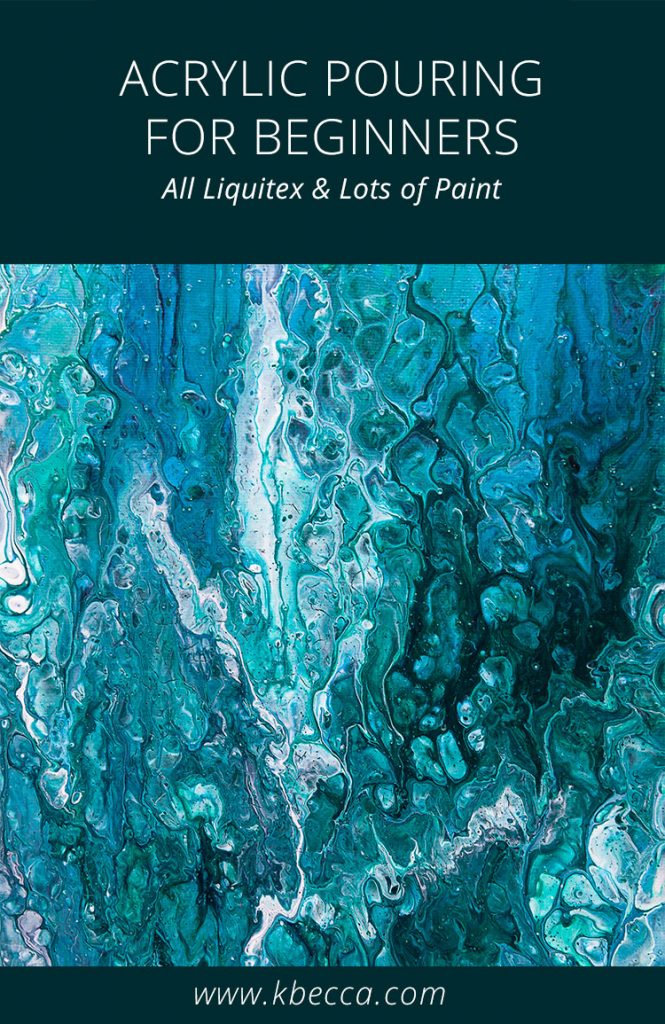
I’ve been wanting to try out the Liquitex Pouring Medium for a while now and thought it would be fun to expand on the Liquitex theme and use Liquitex acrylic paints, too. So, this is an all Liquitex (plus a little bit of water and some silicone oil) pour painting!
For this painting, the colors that I used are Liquitex Basics acrylic paints in Payne’s Gray, Brilliant Blue, and Phthalo(cyaninine) Green, plus Titanium White. I really like how rich and vivid the colors are, even after the paint is dry. They are a thicker consistency than I’ve been used to with the brands of craft paints that I’ve been using for my pour paintings to this point, so there was a little bit more involved in getting them to a good pouring consistency.
My paint to pouring medium to water mixture was 1 to 1 to 1-ish, with slightly less water than paint or pouring medium. I used approximately a Tablespoon and a half (around 20 milliliters) of the paint and pouring medium, plus around a Tablespoon or so (15-ish milliliters) of water. Then I added approximately 1/2 teaspoon (2.5 to 3 milliliters) of silicone oil. And I used double the amount of everything but the silicone oil, which I didn’t use at all, for the Titanium White.
The Liquitex Pouring Medium is nice, but it’s also $$$. An 8 oz. bottle was $9 USD (and that’s a better price – it’s often $10+), and I used the whole bottle on just 3 8 x 10 inch paintings. For me, Floetrol performs just as well and at a much lower price. As of this post, you can buy a 32 oz. bottle of Floetrol on Amazon for around $7 USD.
I did notice some cracking here and there in the paint after the painting was dry, but I’m not sure if this was separation caused by the silicone oil or actual cracking. I have noticed this kind of thing in other paintings when I’ve used other pouring mediums and brands of paint, so this is not unique to Liquitex products.
Since I used so much paint, the flow was much faster than I’m used to, and details in the paint would form and flow away very quickly, so it’s important to pay attention to how much you’re tilting the canvas as you’re working. In the future, I don’t think I’ll use quite as much paint as I did in this painting. It was just overkill. I need to find a happy medium between the minimal amount that I’ve been using and an overkill amount like I used here.
I did really like how the painting turned out, and I’ll definitely be using more of the Liquitex acrylic paints in the future. As for pouring mediums, I’ll stick with either the DIY glue and water mix or Floetrol because I just can’t justify paying so much for the Liquitex pouring medium, even though it did perform well.
Check out the video below to see the “all Liquitex” pour painting process from start to finish:
Supplies Used in This Project
The following supply list contains affiliate links. I make a small commission if you purchase through these links, and I really appreciate it if you do!
Husky Plastic Sheeting (or a large garbage bag / old newspapers / a bunch of plastic grocery bags / a painter’s dropcloth)
Foil Cookie Trays (to catch most of the excess paint as it runs off the edges of the painting – I purchased a set of 2 for $1.00 at the dollar store)
Vinyl / Nitrile Gloves (if you don’t want to be cleaning acrylic paint from under your fingernails for days, then use gloves – I buy mine by the box at Walmart in the cleaning supplies aisle)
Liquitex Pouring Medium, 8 oz.
Liquitex Basics Acrylic Paints in Payne’s Gray, Brilliant Blue, Phthalo(cyaninine) Green, and Titanium White
Plastic Cups (to hold the paint / pouring medium mixture – you can use any small plastic cups for this, or you can save yogurt containers or even plastic cat food containers and use those)
Wood Craft Sticks (to stir the paint / pouring medium mixture – I picked up a package of 100 for $1.00 at the dollar store, and once the paint is completely dry on them, you can reuse them)
Artist’s Loft Brand 8×10 Inch Canvas (Michael’s brand)
Plastic Shot Glasses (to raise the canvas off of the work surface so the paint can flow off the edges after you pour – I bought a package of 24 plastic shot glasses for $1.00 at the dollar store, but you can use food service containers, plastic yogurt containers, cat food containers, or even a small box under the canvas)
Spot On 100% Silicone Treadmill Belt Lubricant to create cells in acrylic pour paintings. I used about 1/2 teaspoon to about 4 – 4 1/2 Tablespoons of the paint/pouring medium/water mixture.

